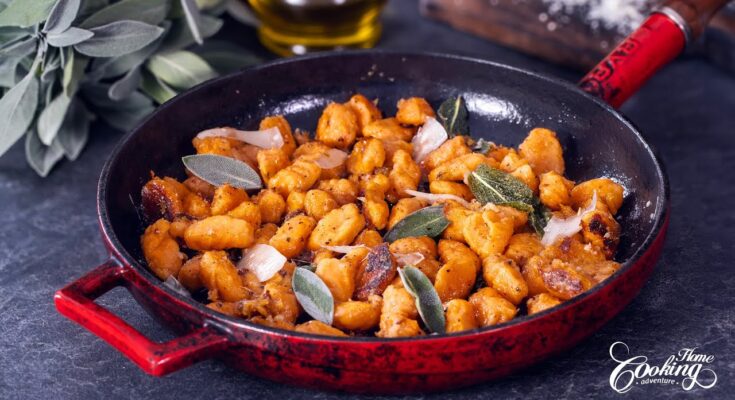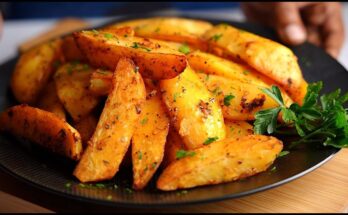Potato Gnocchi Recipe: Potato gnocchi is one of those soul-satisfying dishes that seems simple but is packed with tradition and flavor. These pillowy little dumplings are made primarily from potatoes and flour and are cooked until they’re tender and chewy, making them the perfect vehicle for sauces like tomato, pesto, or brown butter and sage. Pronounced “nyo-kee,” these Italian dumplings are beloved worldwide for their comforting texture and delicate flavor. The key is in mastering the balance—too much flour and they become tough, too little and they fall apart.
Unlike pasta, gnocchi doesn’t rely on eggs or gluten to create structure (though some recipes include egg for richness). Their flavor is mild, but they soak up sauces beautifully, making every bite a little burst of deliciousness. Whether you’re making them for a family dinner or to impress guests, potato gnocchi is a recipe that never goes out of style.
Origins and Cultural Significance
Gnocchi has deep roots in Italian culinary tradition. Historians trace its history back to Roman times, though the modern potato version emerged after potatoes were introduced to Europe from the Americas in the 16th century. Different regions of Italy have their own gnocchi styles, with variations in ingredients like ricotta, semolina, or pumpkin.
In Northern Italy, where potatoes thrive, potato gnocchi is a staple comfort food. Making gnocchi is often a family affair—passed down through generations, taught by nonnas in cozy kitchens. It’s more than a dish; it’s a shared experience. Every Italian household might have its own version, slightly tweaking texture or flour quantity based on preference and climate.
Essential Ingredients for Gnocchi
Choosing the Right Potatoes
The first rule of making stellar gnocchi is using the right kind of potato. Not all potatoes are created equal, especially for gnocchi. You want starchy potatoes like Russets or Yukon Golds. These potatoes have a drier texture and high starch content, which helps hold the gnocchi together without making them gluey or heavy. Avoid waxy potatoes like red or new potatoes—they retain too much moisture and will make the dough sticky and difficult to work with.
When shopping for potatoes, look for ones that are firm and free of blemishes. Older potatoes are actually better here since they tend to be drier. For best results, bake them instead of boiling. Baking helps remove excess moisture, which leads to fluffier gnocchi.
Additional Key Ingredients
While potatoes are the star, the supporting ingredients play essential roles too:
- Flour: All-purpose flour works best. Some chefs use 00 flour for a silkier dough, but regular flour is just fine for home cooks.
- Salt: A touch of salt enhances flavor, added to both the dough and the boiling water.
- Egg (optional): Many traditional Italian gnocchi recipes omit the egg, especially in the north. However, a single egg can help bind the dough if you’re just starting out or your potatoes are too moist.
- Nutmeg (optional): A small pinch adds a subtle depth and warm aroma, giving your gnocchi a sophisticated twist.
These simple ingredients come together with love and a bit of patience to create something truly special.
Equipment You’ll Need
Must-Have Kitchen Tools
You don’t need a lot of fancy tools to make gnocchi from scratch, but a few essentials will make your life easier:
- Potato Ricer or Food Mill: This is non-negotiable if you want fluffy gnocchi. Mashing potatoes can leave lumps that ruin the dough texture.
- Mixing Bowl: For combining your ingredients and kneading the dough.
- Large Pot: For boiling the potatoes and later cooking the gnocchi.
- Slotted Spoon: To fish out the gnocchi once they float to the top.
- Fork: To shape the gnocchi and create those signature ridges (which catch sauce beautifully).
Optional But Useful Tools
If you plan on making gnocchi often, consider investing in these extras:
- Gnocchi Board: A small wooden paddle with grooves that makes shaping easier and more consistent.
- Pastry Cutter or Dough Scraper: For cutting even pieces of dough.
- Digital Scale: Helps with precise flour and potato measurements, crucial for consistent results.
Step-by-Step Gnocchi Preparation Process
Step 1: Boiling the Potatoes
Start with whole, unpeeled starchy potatoes. Place them in a large pot of cold, salted water and bring to a boil. Boiling them with the skin helps keep water from saturating the flesh. Cook until fork-tender—about 20 to 30 minutes depending on size. Don’t overcook, or they’ll absorb too much water.
Once done, let them cool just slightly so you can handle them. Peel while still warm and proceed immediately to the next step. Working with warm potatoes ensures a smoother dough that holds together better.
Step 2: Ricing and Cooling
Now pass your warm, peeled potatoes through a potato ricer or food mill into a large mixing bowl or clean surface. Do not use a traditional masher—lumps will ruin your gnocchi. Spread the riced potatoes out a bit to let steam escape. This reduces moisture and helps with a firmer dough.
Let them cool for about 5–10 minutes. You want them still warm, but not hot enough to cook the egg (if you’re using one). This step is all about texture—light, dry potatoes make light, tender gnocchi.
Step 3: Mixing and Kneading the Dough
Once your potatoes have cooled just enough, it’s time to bring everything together. Create a small well in the center of the riced potatoes. If you’re using egg, crack one into the well and lightly beat it. Begin sprinkling flour over the top—a little at a time—then gently fold the ingredients together. Use your hands for this process, but avoid overworking the dough.
The goal here is to mix just until the flour is incorporated. The dough should be soft, a little sticky, and not too firm. If it feels too wet, dust with more flour, a tablespoon at a time. Kneading for too long activates the gluten, making the gnocchi chewy rather than tender.
A light touch is your best friend. Think of it more like patting the ingredients together than kneading bread. After a few minutes of gentle kneading, you should have a smooth, pliable dough that doesn’t cling aggressively to your hands.
Step 4: Shaping the Gnocchi
Dust a clean work surface with flour. Divide the dough into four equal portions to make it more manageable. Take one portion and roll it into a rope about 3/4 inch thick. Use a knife or dough cutter to slice the rope into small pieces—about 1 inch each.
Now, here’s where gnocchi gets its personality. To shape them traditionally, take each piece and roll it gently down the back of a fork or a gnocchi board. This step adds ridges that help sauces cling better. If you prefer a rustic look, leaving them as soft pillows works just as well.
Place shaped gnocchi onto a floured tray or parchment-lined sheet. Make sure they’re not touching, or they’ll stick together. Continue shaping the rest of the dough. If not cooking immediately, you can freeze them on the tray and transfer to a bag for later use.
Step 5: Cooking the Gnocchi
Bring a large pot of salted water to a gentle boil. It should be bubbling, not furiously boiling—agitation can break apart delicate gnocchi. Drop the gnocchi in batches to avoid overcrowding. Stir very gently to prevent sticking to the bottom.
Within 2 to 3 minutes, they’ll float to the top—that’s your sign they’re done. Scoop them out with a slotted spoon and transfer to a plate. From here, you can add them directly into your favorite sauce or give them a quick pan-fry in butter for crispy edges.
Gnocchi is incredibly versatile. Try it with a sage-brown butter sauce, tossed in pesto, or smothered in marinara and Parmesan. However you serve it, these little potato pillows are sure to impress.
Tips for Perfect Gnocchi
Common Mistakes to Avoid
- Too much flour: Makes the gnocchi dense and rubbery. Start small and add only as needed.
- Overmixing: Handle the dough gently to keep it light.
- Boiling peeled potatoes: This lets them absorb too much water, making the dough sticky.
- Skipping the ricer: A smooth texture is key. Mashers can’t compare.
- Crowding the pot: Causes uneven cooking and clumps.
Expert Secrets for Light, Fluffy Texture
- Bake instead of boil: Roasting your potatoes instead of boiling removes moisture and intensifies flavor.
- Use cold hands: Warm hands can make the dough gummy. Rinse under cold water before kneading.
- Don’t rush the cooling: Letting riced potatoes release steam is a game-changer.
- Test one gnocchi: Boil a single piece to check texture. Adjust flour as needed.
Serving Suggestions for Gnocchi
Classic Sauces That Pair Perfectly
Gnocchi is a culinary chameleon. Its mild flavor and delicate texture make it a perfect canvas for a wide variety of sauces. The right sauce can take gnocchi from simple comfort food to a gourmet experience.
- Brown Butter & Sage: This is an Italian classic. Brown the butter until it smells nutty and golden, toss in a few fresh sage leaves, and coat the gnocchi as they finish cooking. The nuttiness of the butter and the earthy sage make this a go-to pairing.
- Marinara: For a traditional and hearty meal, a well-seasoned tomato marinara sauce with garlic and basil is unbeatable. Top with grated Parmesan or Pecorino Romano for extra flavor.
- Pesto: A fresh basil pesto brings brightness and a punch of garlic and Parmesan to the dish. It’s especially delightful in summer when basil is in peak season.
- Gorgonzola Cream Sauce: If you’re craving richness, a blue cheese cream sauce adds indulgence. It’s bold, tangy, and creamy all in one bite.
- Mushroom Cream Sauce: Sautéed mushrooms with a splash of cream and a hint of thyme turn your gnocchi into a restaurant-worthy plate.
Gnocchi is also delicious baked. Try layering it with cheese, marinara, and herbs in a baking dish, then bake until bubbly and golden. It’s a comforting, crowd-pleasing dish that works well for dinners and special occasions alike.
Creative Gnocchi Variations
Once you’ve mastered traditional potato gnocchi, don’t be afraid to get creative. The beauty of gnocchi lies in its adaptability. Here are some unique twists:
- Sweet Potato Gnocchi: Slightly sweeter and with a gorgeous orange hue, these pair wonderfully with sage butter or a spicy cream sauce.
- Pumpkin Gnocchi: Perfect for fall, pumpkin adds a subtle flavor and a seasonal touch. Spice it with nutmeg or cinnamon.
- Ricotta Gnocchi (Gnocchi di Ricotta): These are lighter and quicker to make, requiring no potatoes. Just mix ricotta, flour, Parmesan, and egg.
- Spinach Gnocchi: Add finely chopped spinach to your dough for an earthy flavor and vibrant green color. Pairs perfectly with creamy sauces.
- Beet Gnocchi: Visually stunning, beet gnocchi are slightly sweet and earthy. Serve with goat cheese or lemon zest for a gourmet flair.
These variations let you tailor gnocchi to your mood, dietary needs, or seasonal produce. The base technique stays the same, giving you a solid foundation to experiment.
Storage and Reheating Tips
Storing Fresh Gnocchi
Gnocchi is best enjoyed fresh, but you can absolutely store it for later. Here’s how:
- Refrigerator: If you plan to cook within 24 hours, arrange the gnocchi in a single layer on a floured baking sheet, cover with plastic wrap, and refrigerate.
- Freezer: For longer storage, freeze gnocchi in a single layer on a tray. Once frozen solid (about 2–3 hours), transfer them to a freezer bag. They’ll keep for up to two months.
Never stack or pack uncooked gnocchi tightly—they’ll stick and become a mess. Always use a dusting of flour to prevent sticking.
Reheating Cooked Gnocchi
Leftover gnocchi can be revived deliciously with a little care:
- Pan-Fry: Sauté in butter or olive oil until crispy. This adds a nice contrast in texture and revives the flavor.
- Microwave: Use a splash of water and microwave in short bursts, stirring gently. This method is quick but can turn the gnocchi soggy.
- Baked: Place in a baking dish with sauce and cheese, then bake until hot and bubbly. A perfect second-day meal!
Never boil cooked gnocchi again—it will break apart and lose its texture. Instead, try to add a new texture or layer of flavor when reheating.
FAQs about Potato Gnocchi Recipe
1. What is potato gnocchi made of?
Potato gnocchi is typically made from just a few simple ingredients: mashed potatoes, flour, and eggs. Some variations may include ricotta cheese or seasonings for added flavor.
2. What type of potatoes are best for gnocchi?
Starchy potatoes like Russets or Yukon Golds are best because they produce a fluffy, light gnocchi dough with minimal moisture.
3. Why is my gnocchi dough sticky?
Sticky dough often means there’s too much moisture. Make sure your potatoes are well-drained and cooled before mixing. Add flour gradually until the dough is smooth and just slightly tacky.
4. Can I make gnocchi without eggs?
Yes, you can make eggless gnocchi. Just increase the flour slightly and handle the dough gently to prevent it from falling apart.
5. How do I know when gnocchi is cooked?
Gnocchi is done when it floats to the top of the boiling water. Remove them promptly to avoid overcooking and becoming mushy.
6. Can I freeze potato gnocchi?
Absolutely. Freeze uncooked gnocchi in a single layer on a tray, then transfer to a freezer bag. Boil straight from frozen when ready to cook.
7. What sauces go well with gnocchi?
Gnocchi pairs well with tomato sauce, brown butter and sage, pesto, creamy Alfredo, or even a light garlic butter sauce.
8. Why did my gnocchi turn out tough?
Overworking the dough or adding too much flour can make gnocchi dense and chewy. Mix just until combined for soft, pillowy results.
Conclusion
Making potato gnocchi at home is a deeply satisfying, rewarding experience. With just a few ingredients—potatoes, flour, and a pinch of salt—you can create something truly special. Whether you stick to the traditional method or explore creative variations, homemade gnocchi offers endless opportunities to impress your taste buds and your guests.
From kneading the dough to shaping each piece by hand, every step brings you closer to a dish that’s rich in tradition and flavor. Once you get the hang of it, you’ll never want to buy store-bought gnocchi again.
So grab some potatoes, roll up your sleeves, and make magic with this timeless Italian comfort food. Your kitchen will smell amazing, and your plate will thank you.



